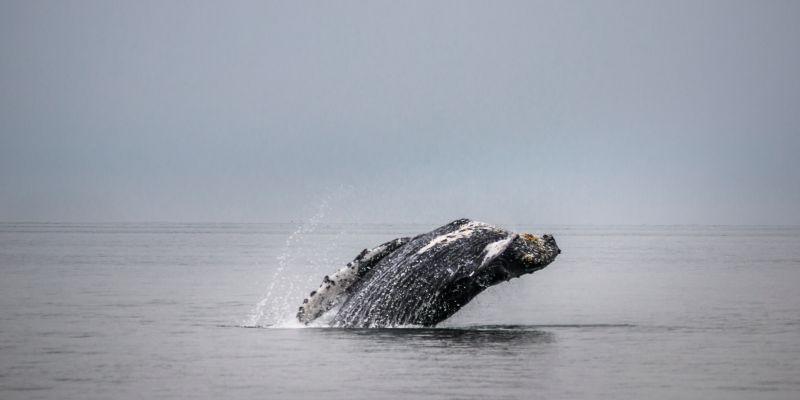While whale watching in Oregon is a year-round activity, the weeks around Christmas and New Year’s Day are truly one of the two best times to see these animals in their natural habitat. Gray whales are the most frequently viewed whale along the Oregon coast and draw thousands of visitors and researchers each year. The activity is not complicated; however, following a couple of tips will make this whale watching season the best one yet!
The first step when you go on an excursion is to find the whale spouts. It will help if you use a pair of binoculars. For a closer look, sign up for a whale watching tour via a charter boat. There are also tours available from a helicopter or airplane.
2019 Winter Whale Watch Week–Friday, December 27 – Tuesday, December 31
Whale Watch Week happens every winter and spring when more than 15,000 gray whales migrate just offshore. The peak migration times also happen to correspond to many people’s vacation times: right around schools’ spring and winter breaks. This winter’s peak is expected to run from mid-December to late January. Volunteers work at state parks along the coast (Crescent City, California, to Ilwaco, Washington) to aid visitors in spotting the passing grays. Plan now to also be here for Spring 2020 Whale Watch Saturday, March 21 – Sunday, March 29.
The Whale Watching Spoken Here program
The Whale Watching Spoken Here program is a great way to see the whales during Whale Watch Week with five primary days of whale spotting along the Oregon coast. Since its founding, the Whale Watching Spoken Here program hosts one of the largest onshore watching events in the United States. But remember, whale watching happens all year, and peak seasons last longer than the “official” Whale Watch Week.
Our Favorite Whale Watching Spots
Start driving north from The River House Inn to…
The Highway 101 turnouts above Baker Beach (about 6 miles north) or Sea Lion Caves (about 11 miles north). Then it’s onward to…
- Rock Creek turnout
- Ocean Beach Picnic Area
- Bray’s Point turnout
- Bob Creek wayside
- Strawberry Hill wayside
Finally, there are several locations at Cape Perpetua, just about 20 miles north of us …
- Highway 101 turnout (Cook’s Chasm)
- Cape Perpetua Visitor’s Center
- The top of the cape (a few minutes’ drive off Highway 101 above the visitor’s center) which will give you a 20+ mile view on a clear day any time of year!
The best spot for whale watching in Oregon
Some of the best spots are just a few miles north up the coastline from our front door. However, the Depoe Bay Sea Wall, 62 miles north of us, is referred to as “the whale watching capital of the coast” and is perhaps the shining star of such spots with a year-round population.
Other good spots
From north to south, below are the 26 Whale Watching Spoken Here sites. With or without a volunteer to assist, these are the best locations along the coast to spot whales.
- Ecola State Park
- Neahkahnie Mountain Historic Marker Turnout on Highway 101
- The Cape Meares State Scenic Viewpoint
- Cape Lookout State Park
- Cape Kiwanda
- Inn at Spanish Head
- Boiler Bay State Scenic Viewpoint
- Rocky Creek State Scenic Viewpoint
- Devil’s Punchbowl State Natural Area
- Yaquina Head Outstanding Natural Area
- Don Davis City Park
- Battle Rock Wayfinding Point
- Cape Sebastian
- Cape Ferrelo
- Harris Beach State Park
What to look for
Now that you know where to go this whale watching season, what about the actual sightseeing? Read on for tips on how to actually spot these magical mammals.
Spot the mist
Unless you’re fortunate to see a breach or a fluke, for the most part, you’ll spot the mist from the whale’s blowhole and the curve of its back as it goes underwater. It can, at times, be challenging to see a spout among the waves, but look beyond the waves for that quick vertical puff of mist. It’s hard to mistake for a wave.
Scan back and forth
Watching whales is similar to watching shooting stars. The more you look in one spot, the easier they are to miss. Ease your eyes and gradually scan the ocean from back and forth. Also look out to the horizon, back to the breaking waves, and everywhere in between. For a closer look, use a camera with a telephoto lens or a pair of binoculars.
Follow the whale
Once you see a whale, you can keep tabs on it for a while as it swims. Migrating gray whales usually travel at about five miles per hour, remaining underwater for around three to five minutes at a time. You can typically tell their direction of travel according to the season: gray whales head north in the spring and south in the winter.
Have some patience
Lack of patience is a common downfall of exasperated whale watchers. Go into it understanding that it can take more than an hour to see a whale, so make sure you’re prepared. When it comes to whale watching in Oregon, the best advice is to take a seat, relax, and enjoy the experience. The thrill of spotting a whale, or an entire pod, is unmatched.
Other winter adventures
Contact us to find out about other Oregon’s winter adventures, including the winter whale watching season. We can answer any questions you have, and our staff can provide plenty of good suggestions. Happy whale watching!

